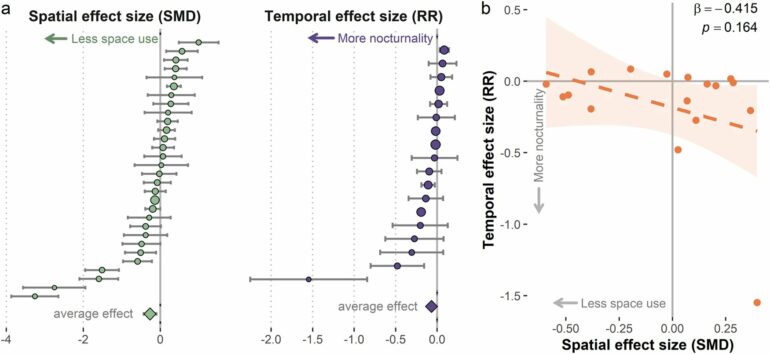Humans and wildlife, including large carnivores, interact at an unprecedented scale as they increasingly share the world’s landscapes. A new University of Michigan-led study of human-lion interactions found that lions tend to avoid human-dominated areas unless they are facing food scarcity and habitat fragmentation.
The findings, published in the journal Communications Biology, suggest that expanding human land use, along with the effects of climate change, could increase the risk of human-lion conflict, which in turn threatens lion populations.
“Our study found that understanding the complex responses of wildlife to human disturbance—such as agricultural land or towns—is a key first step in fostering coexistence between humans and wildlife,” said the study’s lead author, Kirby Mills, a postdoctoral research fellow at U-M’s Institute for Global Change Biology.
“In human-dominated landscapes, wildlife have to balance the tradeoffs between hunting prey and the potentially lethal risks of encountering humans. This is particularly true for large carnivores that often try to kill livestock, because threats to livestock can prompt retaliatory killing of large carnivores, which is a leading cause of large carnivore population declines around the world.”
As almost half of the current range of lions lies outside of protected area boundaries, the carnivores are required to regularly navigate degraded human-dominated landscapes. Yet research addressing the tradeoffs the lions must make—between available prey and risks from humans—is rare, especially at very large spatial scales.
The international team of study authors aimed to contribute to a better understanding of lion responses to human disturbance by reviewing previously published data from 31 study sites spanning 40% of lion ranges worldwide. They found that at more than two-thirds of study sites, lions avoided areas of human activity or hunted primarily at night, particularly in locales dense with cattle ranches.
These behavioral adaptations, however, can impact entire ecosystems.
Neil Carter, associate professor at the School for Environment and Sustainability, and Nathan Sanders, professor and chair at the Department of Ecology and Evolutionary Biology, jointly supervised the study.
“Increasing nocturnal activity to avoid human encounters can influence competition between species, predator-prey dynamics and ecosystem function,” Carter said. “Avoiding human-dominated areas altogether effectively limits the amount of habitat that lions can use and can increase competition, contribute to heightened risks of regional extinction, restructure wildlife community dynamics and, ultimately, reduce biodiversity.”
The study also found that lions are more likely to forage in higher risk areas when seasonal vegetation cover—which predicts prey availability—or human presence is more variable, indicating that lions may be less likely to avoid humans when food is more limited or their habitats are more fragmented. Contributing to all these factors is the unpredictable effects of climate change.
“Climate change across Africa is projected to exacerbate resource stress for humans and wildlife alike, but the effects of climate change are too rarely emphasized in wildlife conservation,” Sanders said. “Our findings reinforce what many others have called for, things like dedicating adequate funding and management capacity to protected areas where lions live, while engaging with and empowering local communities.”
“Successful conservation of large carnivores depends on sustainable coexistence with empowered and supported local communities, especially as the planet gets ever warmer and resources become increasingly limited.”
More information:
Kirby L. Mills et al, Tradeoffs between resources and risks shape the responses of a large carnivore to human disturbance, Communications Biology (2023). DOI: 10.1038/s42003-023-05321-z
Provided by
University of Michigan
Citation:
Study investigates lions’ interactions with humans in a diminishing habitat (2023, October 17)



